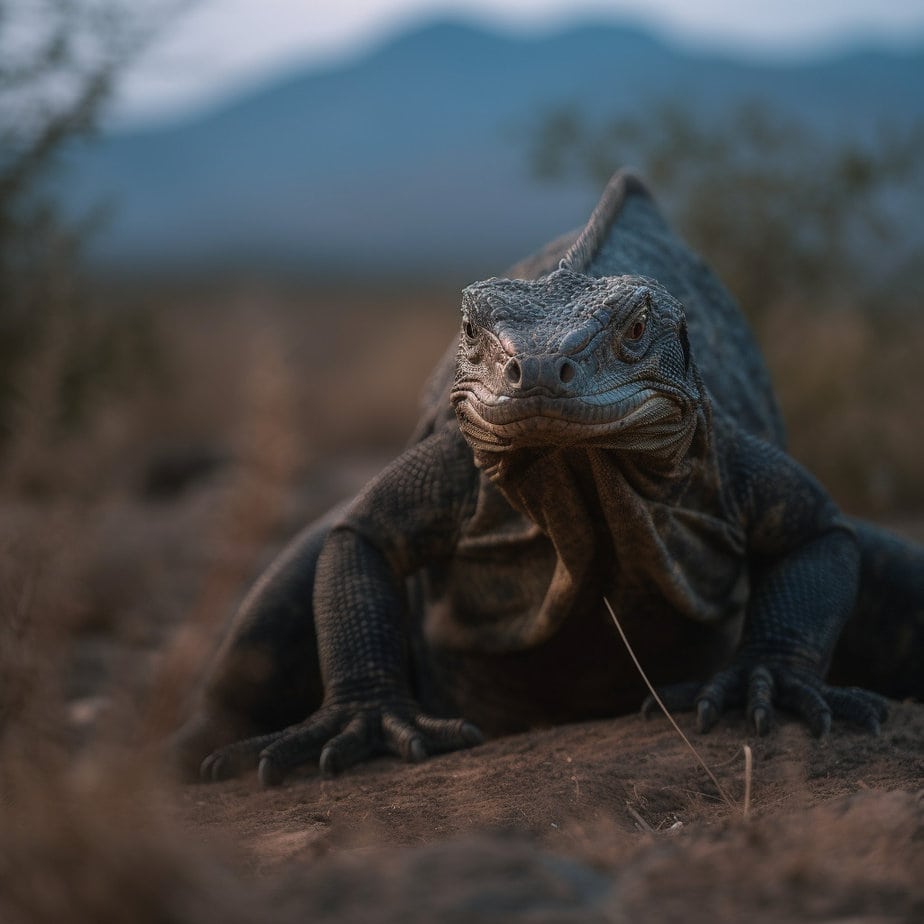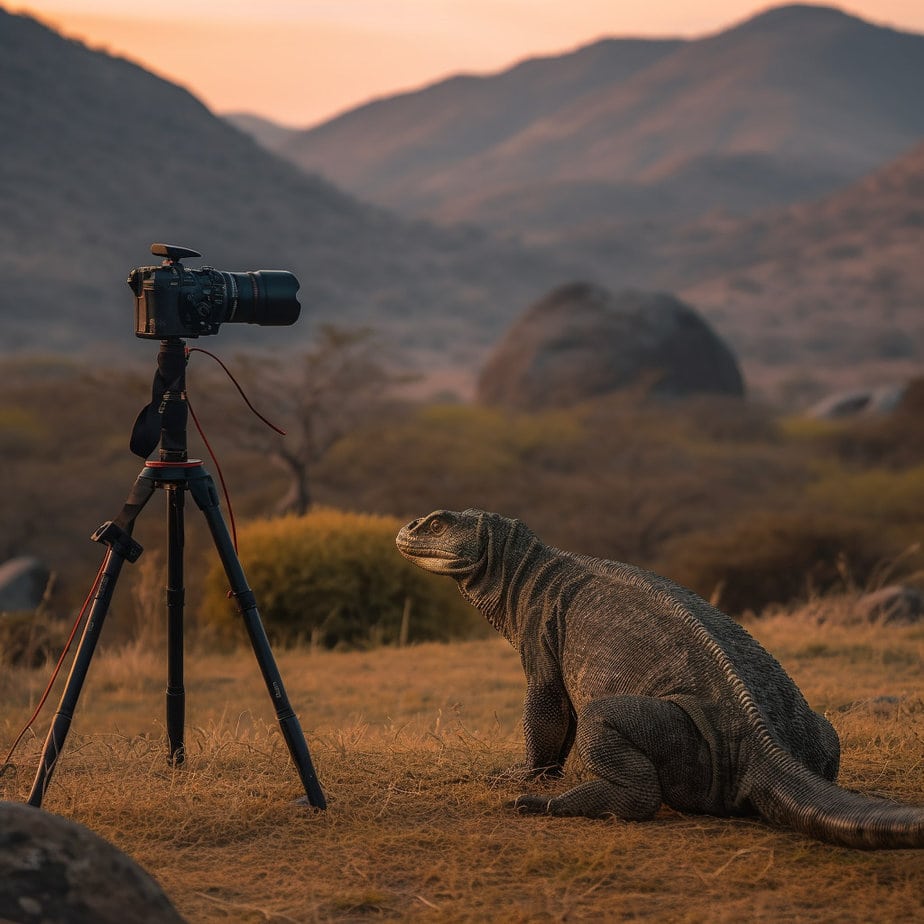The Gila monster and the Komodo dragon are two fascinating reptiles that often capture the imagination of people. While they may share some similarities, they are distinct creatures with unique characteristics. The Gila monster is a venomous lizard native to the southwestern United States and northwestern Mexico, known for its striking orange and black coloration. On the other hand, the Komodo dragon is the largest living lizard and is found in the Indonesian islands of Komodo, Rinca, Flores, Gili Motang, and Padar. In this article, we will explore the differences and similarities between these two remarkable reptiles, delving into their physical attributes, habitats, behaviors, and more. So, let’s dive into the world of the Gila monster and the Komodo dragon and discover what sets them apart.
Key Takeaways
- The gila monster and the komodo dragon are both venomous reptiles, but they belong to different families.
- The gila monster is found in the southwestern United States and northwestern Mexico, while the komodo dragon is native to the Indonesian islands.
- The gila monster has a stocky build and a distinctive pattern of orange and black bands, while the komodo dragon is larger and has rough, scaly skin.
- Both species have powerful jaws and sharp teeth, but the komodo dragon is known for its ability to take down large prey with its strong bite and venomous saliva.
- While the gila monster’s venom is primarily used for defense, the komodo dragon’s venom contains bacteria that can cause a deadly infection in its prey.
- Conservation efforts are in place for both species, as they face threats from habitat loss and illegal trade.
Understanding the Gila Monster

The Gila Monster is a fascinating reptile that belongs to the lizard family. In this section, we will delve into the origin, habitat, physical characteristics, behavioral traits, diet, and hunting techniques of the Gila Monster.
A. Origin and Habitat of the Gila Monster
The Gila Monster, scientifically known as Heloderma suspectum, is native to the southwestern United States and northwestern Mexico. It is primarily found in the Sonoran and Mojave Deserts, as well as the foothills of the Rocky Mountains. These arid regions provide the perfect environment for the Gila Monster to thrive.
These reptiles have adapted to survive in the harsh desert conditions. They are well-equipped to handle extreme temperatures and are often found in rocky areas, sandy washes, and creosote bush flats. The Gila Monster prefers to make its home in burrows or under rocks, seeking shelter from the scorching sun during the day.
B. Physical Characteristics of the Gila Monster
The Gila Monster is a stout and heavy-bodied lizard, with a distinctive appearance that sets it apart from other reptiles. It has a stocky build, short limbs, and a thick tail. On average, an adult Gila Monster measures about 20 to 22 inches in length, making it a relatively small lizard compared to its reptilian counterparts.
One of the most striking features of the Gila Monster is its unique coloration. Its body is covered in black or dark brown scales, adorned with vibrant patterns of orange, yellow, and pink. These bright colors serve as a warning to potential predators, signaling the Gila Monster’s venomous nature.
C. Behavioral Traits of the Gila Monster
The Gila Monster is a solitary and nocturnal creature. It spends most of its time hidden away in its burrow, emerging only at night to hunt for food. Despite its venomous reputation, the Gila Monster is generally docile and prefers to avoid confrontation. It will only bite if it feels threatened or provoked.
When threatened, the Gila Monster exhibits a unique defensive behavior. It opens its mouth wide, hisses loudly, and exposes its venomous saliva. This display is often enough to deter predators and keep them at bay. However, if the threat persists, the Gila Monster will deliver a powerful bite, injecting its potent venom into its attacker.
D. Diet and Hunting Techniques of the Gila Monster
The Gila Monster is primarily carnivorous, feeding on a variety of small animals. Its diet consists mainly of eggs, birds, rodents, lizards, and even the occasional carrion. Despite its slow-moving nature, the Gila Monster is an ambush predator, relying on its keen sense of smell to locate its prey.
Once it detects the scent of potential food, the Gila Monster will patiently stalk its prey until it is within striking distance. It then delivers a quick and powerful bite, latching onto its victim with its sharp teeth. The venom injected through its grooved teeth begins to take effect, immobilizing the prey and allowing the Gila Monster to consume its meal at its leisure.
In conclusion, the Gila Monster is a fascinating reptile with unique characteristics and adaptations that enable it to survive in its desert habitat. Its venomous nature, combined with its colorful appearance, serves as a warning to potential predators. Understanding the origin, habitat, physical characteristics, behavioral traits, diet, and hunting techniques of the Gila Monster provides us with a deeper appreciation for this remarkable lizard species.
Delving into the World of the Komodo Dragon
The Komodo dragon, also known as Varanus komodoensis, is a fascinating creature that has captured the attention of researchers and wildlife enthusiasts alike. Native to the Indonesian islands of Komodo, Rinca, Flores, Gili Motang, and Padar, this formidable reptile is the largest lizard species in the world. Let’s take a closer look at the origin and habitat, physical characteristics, behavioral traits, and diet and hunting techniques of the Komodo dragon.
A. Origin and Habitat of the Komodo Dragon
The Komodo dragon’s natural habitat consists of a diverse range of environments, including tropical rainforests, savannas, and grasslands. These reptiles are primarily found on the Indonesian islands, where they have adapted to both terrestrial and semi-aquatic lifestyles. The islands’ warm climate and abundant prey make them ideal for the survival of these apex predators.
B. Physical Characteristics of the Komodo Dragon
The Komodo dragon is an impressive reptile, with a unique set of physical characteristics that set it apart from other lizard species. These creatures can grow up to 10 feet in length and weigh around 150 pounds, making them the heaviest lizards in the world. They have a stocky build, powerful limbs, and a long, muscular tail that aids in balance and movement.
One of the most distinctive features of the Komodo dragon is its rough, scaly skin, which provides protection against the harsh elements of its environment. Their skin coloration varies, ranging from gray to brown, allowing them to blend seamlessly into their surroundings. Additionally, they have a forked tongue that helps them detect scent particles in the air, aiding in their hunting endeavors.
C. Behavioral Traits of the Komodo Dragon
Komodo dragons are solitary creatures that are known for their territorial behavior. They mark their territories using scent glands located on their cloacal region, leaving behind a distinct odor that warns other dragons to stay away. Despite their solitary nature, they do engage in social interactions during mating season and when competing for food.
These reptiles are also known for their patience and stealth when hunting. They have a keen sense of smell and can detect the scent of carrion from miles away. Once they locate their prey, they use their powerful jaws and sharp teeth to deliver a lethal bite. The saliva of the Komodo dragon contains a potent mix of bacteria, which can cause infections and eventually lead to the death of their prey.
D. Diet and Hunting Techniques of the Komodo Dragon
The Komodo dragon is an apex predator, and its diet mainly consists of carrion. However, they are also skilled hunters and can take down large prey, including deer, pigs, and water buffalo. Their hunting technique involves ambushing their prey and delivering a powerful bite, often targeting vulnerable areas such as the throat or abdomen.
After delivering the initial bite, the Komodo dragon patiently waits for its prey to weaken from the bacteria in its saliva. Once the prey is incapacitated, the dragon proceeds to devour it, tearing off chunks of flesh with its sharp teeth. These reptiles have a remarkable ability to consume large quantities of food in a short period, thanks to their expandable stomachs.
In conclusion, the Komodo dragon is a remarkable creature that has adapted to its unique island habitat. Its physical characteristics, behavioral traits, and hunting techniques make it a formidable predator in its ecosystem. Understanding these aspects of the Komodo dragon allows us to appreciate the complexity and beauty of the natural world.
Comparing the Gila Monster and the Komodo Dragon

A. Size and Physical Appearance: Gila Monster vs Komodo Dragon
When it comes to size and physical appearance, the Gila Monster and the Komodo Dragon are two fascinating reptiles that capture our imagination. Let’s take a closer look at how these venomous lizards differ in terms of their size and appearance.
The Gila Monster, native to the southwestern United States and northwestern Mexico, is a stout and heavy-bodied lizard. It can grow up to 2 feet in length and weigh around 5 pounds. With its stocky build, it has a distinctive appearance, featuring a black body with bright orange or yellow markings. These bold colors serve as a warning to potential predators, indicating that the Gila Monster is venomous.
On the other hand, the Komodo Dragon, found on the Indonesian islands of Komodo, Rinca, Flores, and Gili Motang, is the largest living lizard species in the world. It can reach an impressive length of up to 10 feet and weigh up to 200 pounds. With its long, muscular body and powerful limbs, the Komodo Dragon is a formidable predator. Its rough, scaly skin is a mix of gray, brown, and green, providing excellent camouflage in its island habitat.
| Gila Monster | Komodo Dragon | |————–|—————-| | Length: Up to 2 feet | Length: Up to 10 feet | | Weight: Around 5 pounds | Weight: Up to 200 pounds | | Black body with orange or yellow markings | Gray, brown, and green scales | | Stout and heavy-bodied | Long and muscular body |
B. Hunting Techniques: Gila Monster vs Komodo Dragon
Both the Gila Monster and the Komodo Dragon are skilled hunters, but they employ different techniques to capture their prey.
The Gila Monster is primarily an ambush predator. It spends most of its time hiding in burrows or under rocks, waiting for unsuspecting prey to pass by. When an opportunity arises, it strikes with lightning speed, delivering a venomous bite to immobilize its victim. The Gila Monster’s venom contains toxins that disrupt blood clotting and lower blood pressure, making it an effective tool for subduing its prey.
In contrast, the Komodo Dragon is an active hunter. It uses its keen sense of smell to locate carrion or detect the scent of potential prey. Once it has identified a target, the Komodo Dragon relies on its impressive speed and agility to close in for the kill. With powerful jaws and sharp teeth, it delivers a powerful bite, often targeting the throat or abdomen of its prey. The Komodo Dragon’s saliva contains a mix of bacteria that can cause severe infections, further aiding in the hunting process.
C. Survival Strategies: Gila Monster vs Komodo Dragon
Survival in the wild requires a combination of physical adaptations and behavioral strategies. Both the Gila Monster and the Komodo Dragon have evolved unique characteristics to ensure their survival in their respective habitats.
The Gila Monster has adapted to the harsh desert environment it calls home. Its thick, bumpy skin helps to retain moisture, allowing it to withstand the arid conditions. Additionally, the Gila Monster has the ability to store fat in its tail, providing a source of energy during times of scarcity. This adaptation allows it to survive in an environment where food can be scarce.
The Komodo Dragon, on the other hand, has adapted to its island habitat. Its large size and powerful limbs enable it to navigate through dense vegetation and climb trees if necessary. The Komodo Dragon also has a keen sense of smell, allowing it to locate prey over long distances. Furthermore, it has a unique ability to reproduce asexually, a strategy known as parthenogenesis, which allows females to produce offspring without the need for fertilization.
In conclusion, while the Gila Monster and the Komodo Dragon share some similarities as venomous reptiles, they differ significantly in terms of size, physical appearance, hunting techniques, and survival strategies. These remarkable creatures serve as a reminder of the diverse and fascinating world of reptiles.
The Venomous Bite: A Shared Trait
When it comes to venomous reptiles, both the Gila monster and the Komodo dragon are formidable creatures. While they may inhabit different habitats and have distinct characteristics, one trait they share is their venomous bite. Let’s take a closer look at the venom of each species and compare their potency.
A. The Venom of the Gila Monster
The Gila monster, a native of the southwestern United States and northern Mexico, possesses a potent venom that it delivers through its bite. This venom is produced in glands located in the lower jaw of the lizard. The Gila monster’s venom contains a mixture of toxins, including proteins and peptides, which have various effects on the victim‘s body.
When the Gila monster bites its prey or a potential threat, the venom is injected into the wound through grooves in its teeth. The venom then begins to take effect, causing symptoms such as intense pain, swelling, and a drop in blood pressure. The venom also contains components that affect the victim‘s blood clotting ability, making it difficult for wounds to heal.
B. The Venom of the Komodo Dragon
The Komodo dragon, found on the Indonesian islands of Komodo, Rinca, Flores, and Gili Motang, also possesses a venomous bite. However, the venom of the Komodo dragon is quite different from that of the Gila monster. While the Gila monster’s venom primarily affects the victim‘s blood pressure and blood clotting, the venom of the Komodo dragon has a more complex composition.
The venom of the Komodo dragon contains a combination of bacteria and venom glands located in its lower jaw. When the Komodo dragon bites its prey, the bacteria in its mouth are introduced into the wound. These bacteria, along with the venom, have a synergistic effect, causing a rapid infection. The venom also contains toxins that disrupt blood clotting and induce shock in the victim.
C. Comparing the Venom: Gila Monster vs Komodo Dragon
While both the Gila monster and the Komodo dragon possess venomous bites, there are notable differences in the composition and effects of their venom. Here are some key points of comparison:
| Gila Monster | Komodo Dragon | |————–|—————| | Venom primarily affects blood pressure and clotting | Venom causes rapid infection and disrupts blood clotting | | Venom contains proteins and peptides | Venom contains bacteria and toxins | | Bite causes intense pain, swelling, and drop in blood pressure | Bite induces shock and rapid infection |
It is important to note that while the venom of both species can be dangerous, they primarily use their venom as a means of subduing prey rather than as a defense mechanism against predators or humans. Both the Gila monster and the Komodo dragon have evolved to rely on their venomous bites as part of their survival strategies in their respective habitats.
In conclusion, the venomous bite is a shared trait between the Gila monster and the Komodo dragon, although their venom compositions and effects differ. Understanding the unique characteristics of these reptiles helps us appreciate the diversity of adaptations in the animal kingdom.
Conservation Status: Threats and Protection

A. Threats to the Gila Monster and Conservation Efforts
The Gila Monster, a venomous lizard species native to the southwestern United States and northwestern Mexico, faces several threats to its survival. Habitat loss and fragmentation due to urbanization and agricultural expansion are major concerns. As human populations grow, the Gila Monster’s natural habitat is being increasingly encroached upon, leading to the destruction of its preferred desert and scrubland habitats.
Another significant threat to the Gila Monster is the illegal pet trade. These unique reptiles are often sought after by collectors due to their striking appearance and venomous nature. The capture and removal of Gila Monsters from the wild for the pet trade can have a detrimental impact on their populations, especially when combined with other threats.
To protect the Gila Monster, conservation efforts have been implemented. These efforts primarily focus on habitat conservation and public awareness. Various organizations work to preserve and restore the Gila Monster’s natural habitat, ensuring that suitable areas are protected from development. Additionally, educational campaigns are conducted to raise awareness about the importance of conserving this species and the potential consequences of illegal pet trade.
B. Threats to the Komodo Dragon and Conservation Efforts
The Komodo Dragon, the largest living lizard species found on the Indonesian islands of Komodo, Rinca, Flores, and Gili Motang, also faces numerous threats to its survival. One of the primary concerns is habitat loss and degradation. Deforestation, primarily driven by human activities such as logging and agriculture, has resulted in the loss of the Komodo Dragon’s natural forest habitat. This loss of habitat limits the available resources and space for the species, making it more vulnerable to extinction.
Another significant threat to the Komodo Dragon is poaching. Despite being a protected species, illegal hunting for their skins, body parts, and live specimens persists. The demand for these items in the illegal wildlife trade poses a severe threat to the population of Komodo Dragons.
Conservation efforts for the Komodo Dragon focus on habitat protection, law enforcement, and community engagement. National parks and reserves have been established to safeguard the remaining habitats of the Komodo Dragon. Strict regulations and enforcement measures are in place to combat poaching and illegal trade. Additionally, local communities are involved in conservation initiatives, promoting sustainable practices and raising awareness about the importance of protecting this iconic species.
In conclusion, both the Gila Monster and the Komodo Dragon face significant threats to their survival. Habitat loss, illegal pet trade, and poaching are among the primary concerns for these venomous reptiles. However, through dedicated conservation efforts, including habitat protection, law enforcement, and public awareness campaigns, there is hope for the long-term survival of these remarkable species. It is crucial for individuals, communities, and governments to work together to ensure the protection and preservation of these unique reptiles for future generations. Conclusion
In conclusion, both the Gila monster and the Komodo dragon are fascinating reptiles with unique characteristics. While the Gila monster is known for its venomous bite and colorful appearance, the Komodo dragon is renowned for its massive size and powerful bite. Despite their differences, both species play important roles in their respective ecosystems. The Gila monster is a valuable predator that helps control populations of small mammals and reptiles, while the Komodo dragon is a top predator that helps maintain the balance of its island habitat. Both reptiles have adapted to survive in harsh environments and have evolved fascinating features to aid in their survival. Whether it’s the Gila monster’s venomous bite or the Komodo dragon’s ability to take down large prey, these reptiles are truly remarkable creatures. So, next time you come across a Gila monster or a Komodo dragon, take a moment to appreciate their beauty and the important roles they play in the natural world.
Frequently Asked Questions
1. What are the key characteristics of a Gila monster?
Gila monsters are venomous lizards native to the southwestern United States and northwestern Mexican desert. They are known for their distinctive bumpy skin, which is covered in bead-like scales, and their bright color patterns. Gila monsters are slow-moving and spend most of their lives in burrows. They have a powerful bite used to deliver venom to their prey.
2. What are the main features of a Komodo dragon?
Komodo dragons are the largest living lizards in the world, found in the Indonesian islands. They can grow up to 10 feet in length and weigh up to 200 pounds. They have a robust body, a long, flat head with a rounded snout, scaly skin, bowed legs, and a large, muscular tail. They are carnivorous, with a diet that includes carrion, deer, pigs, and even water buffalos.
3. How does the venom potency differ between Gila monsters and Komodo dragons?
Gila monsters have venom that is as potent as that of some rattlesnakes. The venom is neurotoxic, causing pain, swelling, and weakness in humans. On the other hand, Komodo dragons have venom glands loaded with toxins that lower blood pressure, cause massive bleeding, prevent clotting, and induce shock. However, the venom of Komodo dragons is not as potent as that of Gila monsters.
4. How does the size of a Gila monster compare to a Komodo dragon?
Gila monsters are much smaller than Komodo dragons. An adult Gila monster typically measures up to 2 feet in length and weighs up to 5 pounds. In contrast, Komodo dragons can grow up to 10 feet in length and weigh up to 200 pounds, making them the largest living lizards in the world.
5. What are the differences in the habitats of Gila monsters and Komodo dragons?
Gila monsters are found in the desert regions of the southwestern United States and northwestern Mexico. They prefer rocky foothills and avoid open areas. On the other hand, Komodo dragons inhabit the Indonesian islands, where they live in hot and dry savanna conditions, as well as tropical rainforests.
6. How does the diet of a Komodo dragon differ from other reptiles?
Komodo dragons are carnivores and scavengers. They eat a wide range of food, including carrion, deer, pigs, smaller dragons, and large water buffalos. They have been known to eat up to 80% of their body weight in a single meal. This is quite different from many other reptiles, including Gila monsters, which have a diet primarily consisting of small mammals, birds, frogs, and insects.
7. What are the survival strategies of Gila monsters and Komodo dragons?
Gila monsters spend most of their time in burrows or rock shelters to avoid the desert heat and predators. They are also venomous, which helps them secure food and deter threats. Komodo dragons, on the other hand, rely on their size, speed, and powerful bite to hunt and protect themselves. They also have a keen sense of smell to locate carrion from miles away.
8. How long do Gila monsters and Komodo dragons live?
Gila monsters have a lifespan of up to 20 years in the wild, while Komodo dragons can live up to 30 years. Both species can live longer in captivity due to the absence of predators and availability of regular food.
9. How do Gila monsters and Komodo dragons fit into predator-prey relationships?
Gila monsters, being venomous, are predators of small mammals, birds, frogs, and insects. They are preyed upon by birds of prey, coyotes, and foxes. Komodo dragons are apex predators, hunting and eating a variety of animals. Young Komodo dragons are preyed upon by adults, birds of prey, and other carnivorous animals.
10. What are the conservation statuses of Gila monsters and Komodo dragons?
Gila monsters are protected by law in all states of their range due to their declining population. They are listed as Near Threatened by the IUCN. Komodo dragons are listed as Vulnerable by the IUCN. Their populations are threatened by habitat loss, a decline in prey, and human activities. Conservation efforts are in place for both species to protect their habitats and ensure their survival.




